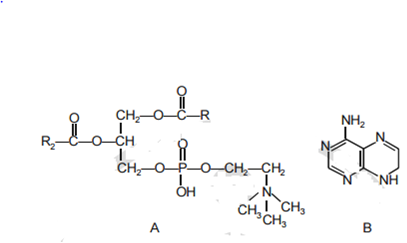 Multiple Choice Questions
Multiple Choice QuestionsWhich one of the following structural formulae of two organic compounds is correctly identified along with its related function?
A: Triglycerid e- major - source of energy
B: Uracil - a component of DNA
A - Lecithin - a component of cell membrane
A - Lecithin - a component of cell membrane
Which one of the following organisms is not an example of eukaryotic cells?
Escherichia Coil
Euglena Viridis
Amoeba proteus
Amoeba proteus
When two unrelated individuals or lines are crossed, the performance of F1 hybrid is often superior to both its parents. This phenomenon is called
transformation
splicing
metamorphosis
metamorphosis
Bacillus thuringiensis forms protein crystals, which contain insecticidal protein
binds with epithelial cells of midgut of the insect pest ultimately killing it
is coded by several genes including the gene cry
is acitvated by acid of pH of the foregut is the insect pest
is acitvated by acid of pH of the foregut is the insect pest
In history of biology, human genome project led to the development of
biotechnology
biomonitoring
bioinformatic
bioinformatic
The genetically - modified (GM) brinjal in India has been developed for
insect - resistance
enhancing self- life
enhancing mineral content
enhancing mineral content
Restriction endonucleases are enzymes which
make cuts at specific positions within the DNA molecule
recognize a specific nucleotide sequence for binding of DNA ligase
restrict the action of the enzyme DNA polymerase
restrict the action of the enzyme DNA polymerase
Stirred -tank bioreactors have been designed for
the addition of preservatives of the product
purification of the product
ensuring anaerobic conditions in the culture vessel
ensuring anaerobic conditions in the culture vessel
What is true about Bt toxin
The inactive protoxin gets converted into active form in the insect gut
Bt protein exists as active toxin in the bacillus
The activated toxin enters the ovaries of the pets to sterilise it and thus prevent its multiplication
The activated toxin enters the ovaries of the pets to sterilise it and thus prevent its multiplication
